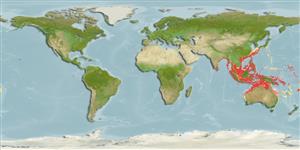Environment: milieu / climate zone / depth range / distribution range
Ökologie
seewasser demersal; tiefenbereich 20 - 260 m (Ref. 12260). Tropical
Indo-West Pacific: Andaman and South China seas south to the Arafura Sea (Ref. 9819) and northern Australia.
Size / Gewicht / Alter
Maturity: Lm ? range ? - ? cm
Max length : 38.0 cm TL Männchen/unbestimmt; (Ref. 2117); common length : 25.0 cm TL Männchen/unbestimmt; (Ref. 2117)
Body elongate, cylindrical. Back and upper sides brown, lower sides and belly white. Nine to 10 faint blotches along the lateral line, sometimes with traces of very indistinct cross-bars on the back. Upper edges of pectoral and caudal fins occasionally with faint black dots. The upper portion of the inner side of the pectoral fins dark.
Inhabits muddy bottoms of the continental shelf down to about 60 m. Feeds on small bottom-dwelling invertebrates and fishes.
Life cycle and mating behavior
Geschlechtsreife | Fortpflanzung | Ablaichen | Eier | Fecundity | Larven
Rau, N. and A. Rau, 1980. Commercial marine fishes of the Central Philippines (bony fish). German Agency for Technical Cooperation, Germany. 623 pp. (Ref. 393)
IUCN Rote Liste Status (Ref. 130435)
Bedrohung für Menschen
Harmless
Nutzung durch Menschen
Fischereien: kommerziell
Mehr Information
NamenSynonymeMetabolismusRäuberÖkotoxikologieFortpflanzungGeschlechtsreifeAblaichenSpawning aggregationFecundityEierEientwicklung
ReferenzenAquakulturAquakultur ProfilZuchtlinienGenetikElectrophoresesVererbbarkeitKrankheitenVerarbeitungNutrientsMass conversion
PartnerBilderStamps, Coins Misc.LauteCiguateraGeschwindigkeitSchwimmstilKiemenoberflächeOtolithsGehirngrößeSehfähigkeit
Tools
Zusatzinformationen
Download XML
Internet Quellen
Estimates based on models
Preferred temperature (Ref.
123201): 19.4 - 28.2, mean 26.2 °C (based on 810 cells).
Phylogenetic diversity index (Ref.
82804): PD
50 = 0.5000 [Uniqueness, from 0.5 = low to 2.0 = high].
Bayesian length-weight: a=0.00513 (0.00345 - 0.00763), b=3.10 (2.98 - 3.22), in cm total length, based on LWR estimates for this species & Genus-body shape (Ref.
93245).
Trophic level (Ref.
69278): 4.3 ±0.5 se; based on diet studies.
Generation time: 2.7 ( na - na) years. Estimated as median ln(3)/K based on 2
growth studies.
Widerstandsfähigkeit (Ref.
120179): hoch, Verdopplung der Population dauert weniger als 15 Monate. (K=0.40-0.88).
Fishing Vulnerability (Ref.
59153): Low vulnerability (20 of 100).
